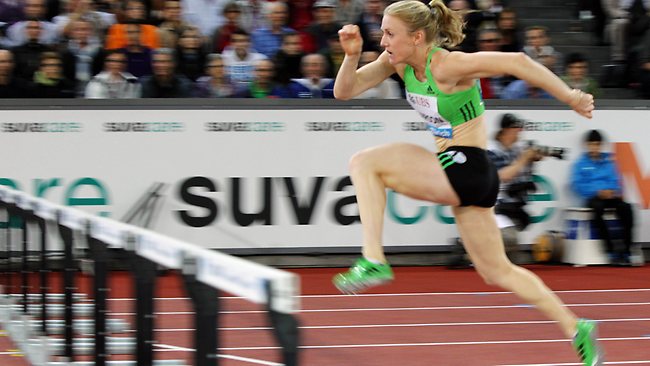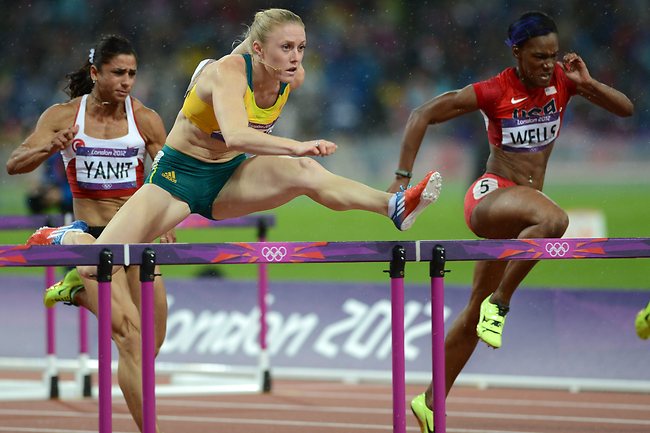Timing Aspect of Take-off into Hurdle
Probably one of the more overlooked aspects of hurdling is the timing aspect. It’s not just important to do everything right when going into the hurdle, but to do everything right on time. If the timing is off, that can throw off the technique, the speed, the balance. For hurdlers, it’s not just important to know what each body part is supposed to do, but to know what they’re supposed to do in relation to each other. In this article I will discuss what happens during take-off with the trail leg, lead leg, lead arm, chest, and hips (in that order). Then I will discuss how the cut step (the last step before the hurdle) sets it all up.
Trail Leg
I would argue that the trail leg plays the most important role in hurdle clearance, and that its vital functions begin with take-off. Before it even becomes a trail leg, it is the leg that propels you into hurdling position. This stride into the hurdle should be very forceful, very powerful, and very explosive. I tell my hurdlers to get a “big push” off the back leg. Also, this leg must fully extend. You can’t get good explosive push off a bent back leg. Without a big push and full extension, the lead leg will be forced to kick out sooner so that you can cover the ground necessary to clear the hurdle.
[am4show not_have=”g5;”]
[/am4show][am4guest]
[/am4guest][am4show have=”g5;”]
Lead Leg
While the trail leg is pushing off and extending, the knee and heel are driving upward. The most common technical mistake I’ve seen among hurdlers is that they extend the lead leg while they’re taking off, putting all the responsibility on the lead leg to do all the heavy lifting in clearing the hurdle. The heel action is very important. The heel should come up, underneath the hamstring, so that the knee can lead the way. If the heel moves forward, toward the hurdle, then the foot will be leading the way, and balance issues will arise.
Lead Arm
While the trail leg is pushing off and extending, and the knee and heel of the lead leg are driving upward, the hand of the lead arm is also driving upward. With the elbow bent, the hand should raise no higher than the forehead. While it’s okay to open the elbow in order to give the trail leg room to pull through, you do not want the lead arm to cross to the other side of the body. If it does, it will swing sideways as you descend off the hurdle instead of pulling down. What goes up comes down; what swings in one direction will swing back in the other direction.
Trail Arm
While the trail leg is pushing off and extending, and the knee and heel of the lad leg are driving upward, and the hand of the lead arm is also driving upward, the hand of the trail arm drives downward to the back pocket. As with the lead arm, the elbow of the trail arm should stay bent. Common trail arm problems include the following:
- It swings away from the body (causing the lead arm to cross the body),
- It goes past the back pocket (causing the shoulder to raise),
- It wraps around the lower back.
All these problems keep you in the air longer and cause reciprocal problems in the lead arm.
Chest
While the trail leg is pushing off and extending, and the knee and heel of the lead leg are driving upward, and the hand of the lead arm is driving upward, and the hand of the trail arm is driving downward to the back pocket, the chest is pushing down over the thigh of the lead leg. A hurdler’s lean should come from the waist, not the upper back, so that the chest can push down properly. If the lean comes from the upper back, the eyes will look down and you will lose sight of where you are going. That’s not a disastrous problem, but it does slow you down, because your upper body momentum is no longer moving forward. An even bigger issue with leaning from the lower back is that it causes the lead leg to straighten, preventing you from leading with the knee.
I don’t really like calling the chest-over-thigh action a “lean.” I use that word for lack of a better one. But really, what you are doing is just pushing the chest further forward, as proper running posture includes pushing the chest forward. The presence of the hurdle requires that you push it forward further, which causes it to push down over the thigh.
As far as timing goes, the movement of the lean is often the aspect of technique that is most often mis-timed. In many cases, the hurdler will push off with the back leg and drive the knee of the lead leg, and then try to lean. But it’s too late. If you try to lean after you’ve taken off, you pretty much won’t be able to lean at all. Which is why you see a lot of hurdlers clobbering hurdles with a low trail leg. The action of pushing the chest down over the thigh naturally raises the trail leg.
Hips
While the trail leg is pushing off and extending, and the knee and heel of the lead leg are driving upward, and the hand of the lead arm is driving upward, and the hand of the trail arm is driving downward to the back pocket, and the chest is pushing down over the thigh of the lead leg, the hips are pushing forward. The hips are the only part of the body moving forward, and it is vital that the hips push forward. The forceful push off the back leg coincides with a forceful thrust of the hips. For many hurdlers who have too much airtime, and who lose momentum and speed while clearing the hurdle, the hips rise with the knee of the lead leg. So the weird thing about hurdling is that you’re in too directions at the same time – upward and forward. The legs are moving upward, the hips are moving forward. The upward motion of the legs enables you to clear the hurdle while the forward motion of the hips enables you to accelerate or at least maintain speed.
For smaller hurdlers, especially males, there may need to be a slight raising of the hips. In such cases, the trick is to make it so that the hips are kind of cycling over the hurdling, moving in a motion that is forward and upward and the same time.
Cut Step
As I said earlier, the cut step is the last step leading into the hurdle. It’s very important that this step be shorter than the previous step (hence the term cut step) to facilitate the forceful push necessary off the back leg. If the last step into the hurdle is too long, and is not shorter than the previous step, then you will clear the hurdle in parts – lead led, then trail leg, with a noticeable pause on top of the hurdle. You won’t have one continuous, fluid motion.
***
Now let’s take a look at a couple photos. Keep in mind that it’s hard to find photos of hurdlers while they’re taking off; almost all photos of hurdlers are taken while they’re on top of the hurdle, or coming off the hurdle. But I found a couple good ones.
 In the photo above of Sally Pearson, let’s go down the checklist:
In the photo above of Sally Pearson, let’s go down the checklist:
- She’s getting a good push off the back leg. It is not quite finishing extending, but it will, as still photos can sometimes be misleading.
- She has excellent lead leg action as well, with the knee driving up and the heel coming up under the hamstring. The knee is higher than the crossbar, high enough that she can already begin descending to the track when she extends it. This is what leading with the knee looks like.
- Her lead arm is perfect as far as I’m concerned. Elbow bent, hand at eye-level.
- The trail arm is a little far back for my liking. I would like for her to bend the elbow a little more so that the arm can punch back up faster as she begins to descend on the other side of the hurdle.
- Chest is pushing down over the thigh. The key is not so much how deeply, but the angle, and her angle is exquisite.
- Hips are pushing forward, giving her forward momentum.
- Overall, this is about as good as it gets.
 In the photo above, you can see what I was talking about regarding Sally’s lead leg already being in descent when she extends it. But let’s focus here on Kellie Wells on the right. Kellie, it can be argued, seems to be in even better position than Sally in the previous photo. Here, you can see the full extension of the trail leg I was talking about. Going down the checklist, Kellie looks to be pretty much the same in all aspects as Sally was. But take a close look at Kellie’s trail arm. Like Sally’s in the previous photo, it has moved a little too far behind her instead of locking in on that back pocket. However, the reason Kellie’s trail arm is not as good as Sally’s is because Kellie’s is slightly moving outward, away from her body. Little, infinitesimal things like that can make all the difference in the world at that level of competition. It also seems to me (although, again, with still photos it can be hard to tell) that there is a slight twist in Kellie’s hips to the lead leg side.
In the photo above, you can see what I was talking about regarding Sally’s lead leg already being in descent when she extends it. But let’s focus here on Kellie Wells on the right. Kellie, it can be argued, seems to be in even better position than Sally in the previous photo. Here, you can see the full extension of the trail leg I was talking about. Going down the checklist, Kellie looks to be pretty much the same in all aspects as Sally was. But take a close look at Kellie’s trail arm. Like Sally’s in the previous photo, it has moved a little too far behind her instead of locking in on that back pocket. However, the reason Kellie’s trail arm is not as good as Sally’s is because Kellie’s is slightly moving outward, away from her body. Little, infinitesimal things like that can make all the difference in the world at that level of competition. It also seems to me (although, again, with still photos it can be hard to tell) that there is a slight twist in Kellie’s hips to the lead leg side.
To summarize, I just want you to be aware of how the limbs work together during take-off, how taking off is one motion in which several things all take place at once.
[/am4show]
